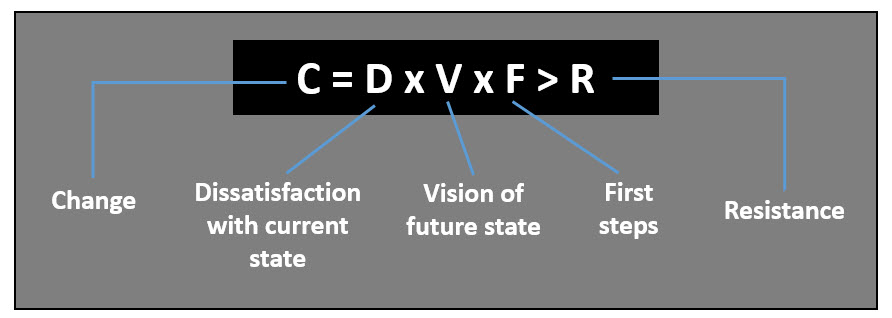When was the last time you gave an impromptu update over lunch on the back of a napkin to explain that big change project you are leading? Did you run out of space on the napkin or were you able to succinctly capture and explain where and why the project was – or was not – on target?
In this situation, I use the five variables of the Formula for Change to explain the change. Much like the scientific formulas we memorized (and mostly forgot) from high school math, chemistry, and physics classes, this formula identifies key variables and describes their dynamic nature to calculate the probability of success.
The Formula for Change, first developed in the 1960s by David Gleicher and later refined by Kathie Dannemiller in the 1980s, identifies the following variables as a mathematical formula.
- C = The change you seek.
- D = Dissatisfaction with the current state and status quo. The dissatisfaction should create a sense of urgency to change and be documented as part of the business case for change.
- V = A vision and clear understanding of future state and what you hope to achieve.
- F = First steps to get started as defined in a change strategy to reach the future state.
- R = Resistance from leaders and people in the organization. While people often naturally resist change, this opposition must be addressed for change to be successful.
Just like a math formula, if any of the three variables (D, V, or F) equals zero, the multiplication factor will cause the sum of the three variables to also become zero – indicating that the change will not succeed. Thus, you should identify and gather hard and soft data to measure dissatisfaction with the status quo, the vision for the future, and first steps to assess readiness for and progress towards the change. If the sum of these three variables is not greater than the amount of overt or covert resistance towards the change, you are not ready to begin your change journey – or your current change journey is not yet strong enough to succeed.
As you assess each variable, consider the following tips to shore up your organizational change plan and overcome any resistance.
Tip #1: Simply sending out “communications” to people about the D, V, and F will rarely garner enough awareness and support to outweigh the resistance that people will naturally feel and express about the changes. Instead of turning up the volume and heat behind formal communications, find ways to communicate with managers and employees and engage them in the planning and implementation of the change. In the words of Dale Carnegie, “People support a world they helped create”.
Tip #2: Build a communication plan that facilitates face-to-face dialogue and two-way communication. Before the Business Case for Change is presented by the executive sponsor at an All Hands/Town Hall meeting, share and discuss information about the change with managers in advance. This will help them prepare to engage their teams following the large group meeting. In these smaller meetings, managers can further discuss the D, V, and F at a local level, resolve concerns, and build trust with employees that managers will to share additional information about the change as it becomes available. Your goal is to increase understanding and decrease resistance through more open and collaborative dialogue rather than simply pushing out information to people’s email boxes.
Tip #3: When using the Formula for Change to assess readiness for change, do not rely solely on the senior management team as your sample population. Due to their position in the organization and frequent involvement in strategic planning, this group may report very positive numbers in the D, V, and F and low R numbers . This can create the perception that your planned organizational change is on track. However, change always has a personal impact for people and organizations are made up of people. Remember that individuals at middle and lower levels of the organization process change differently and they also need to achieve a positive score on the Formula for Change prior to the organization achieving a cumulative positive score.
So now you can illustrate and explain the Formula for Change on the back of a napkin. Yet, much more could be written about each variable and how they relate and contribute to successful adoption of the change. How has this formula helped you and the organizational change projects you lead?


